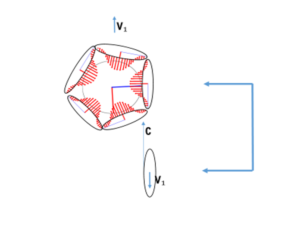Inertia is the process by which entities and constructs adjust to accommodate a potential breach of the speed of light in one or more internal manifestations.
Forming the construct changes the speed of the constituents. The speed of manifestations has to adjust by reducing the system’s frequency and transferring from free electric energy into free magnetic energy, the gravitational monopolar attraction.
When the components are spatially locked within a construct, and that construct begins to accelerate, a new scenario is activated to prevent any constituent from exceeding the speed of light. Acceleration refers to increasing the speed of the construct in a specific direction. In response to this acceleration, the construct generates vibrations to counteract any potential breach of the speed of light. The final compensatory vibrations within the construct are sensitive to the direction of movement.
A simple illustration is for the dodecahedron:

When the dodecahedron, part of a twin-dodecahedron, accelerates to speed V, all 12 electrons receive specific vibrational compensation per face. It reflects the direction and value of the speed V. When the dodecahedron rotates, the electrons adjust vibrationally to the local spatial requirements. The direction and velocity of the speed within the construct are therefore conserved.
These vibrational responses are within the construct and preserve the history of acceleration of the construct, irrespective of the complexity of the construct.
An observer moving through space at the same speed as an object does not notice any increase in energy within the system’s inertia. This observer can also accelerate the object, and the system will adapt to the new situation by rearranging its inertial response. The observer may perceive this as an absolute inertial reaction of the object, but it is, in fact, relative.
The consequence of this postulate is that the planet Earth has, in all its constituent twin-dodecahedrons, the preserved history of its journey through space and time in a single directional speed vector.
